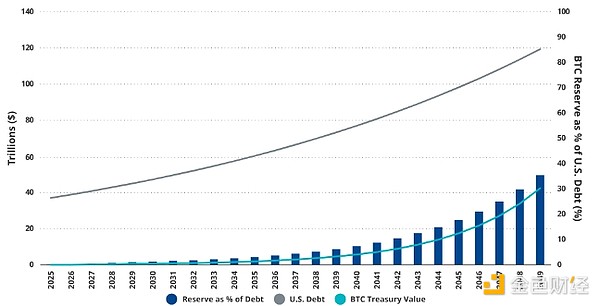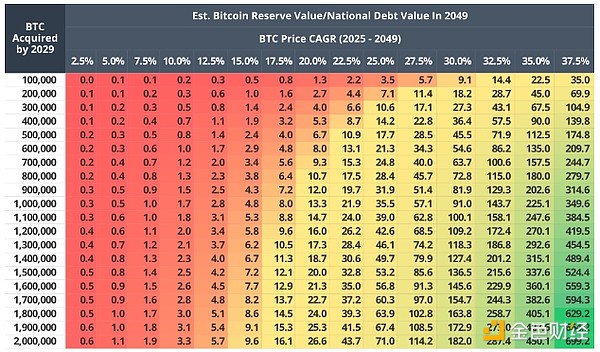Author: Brayden Lindrea, CoinTelegraph; Compiler: Deng Tong, Golden Finance
Asset management company VanEck said that if the United States establishes a reserve of 1 million bitcoins as proposed by Senator Cynthia Lummis, the United States can reduce its national debt by 35% in the next 24 years.
VanEck estimates that by 2049, Bitcoin's compound annual growth rate (CAGR) will reach 25%, reaching 42.3 million US dollars, while the US national debt will increase by a compound annual growth rate of 5%, from 37 trillion US dollars at the beginning of 2025 to 119.3 trillion US dollars.
VanEck digital asset research director Matthew Sigel and investment analyst Nathan Frankovitz said in a report on December 20: "By 2049, this reserve could account for 35% of the national debt, offsetting about $42 trillion in debt."

It is expected that between 2025 and 2049 In 2018, the U.S. national debt would increase as Bitcoin reserves grow. Source: VanEck
The “optimistic” forecast assumes Bitcoin’s 25% compound annual growth rate would start at a price point of $200,000 in 2025. Bitcoin, currently trading at $95,360, would need to more than double to reach the starting point noted by VanEck.
A price of $42.3 million for Bitcoin would mean it accounts for around 18% of global financial assets — far higher than the roughly 0.22% it represents of today’s $90 trillion market.

The estimated compound annual growth rate of US Treasury and Bitcoin reserve holdings and Bitcoin value is 25%. Source: VanEck
The idea of a Bitcoin reserve was proposed by the new administration of Donald Trump, which has driven the price of Bitcoin to more than six figures, but Senator Loomis' bill has still not been reviewed by the Senate or the House of Representatives.
Strike founder and CEO Jack Mallers claimed earlier this month that Trump may issue an executive order designating Bitcoin as a reserve asset on his first day in office.
Under the Lummis Act, the U.S. could repurpose 198,100 bitcoins it holds as a result of asset seizures, while the remaining 801,900 bitcoins could be financed through emergency backstops, by selling a portion of its $455 billion gold reserves in exchange for bitcoin, or both — all without printing money and taxpayer dollars, VanEck noted.
Bitcoin adoption at the state, institutional, and corporate levels in the U.S. would also boost compound annual growth estimates for issuers of bitcoin and ethereum exchange-traded funds, Sigel and Frankovitz said.
Nation-state members of the BRICS (Brazil, Russia, India, China, and South Africa) alliance could also influence bitcoin’s price and its growing use as a currency, Sigel explained in a Dec. 21 X post.
“There is a strong possibility that bitcoin could become widely used as a settlement currency for global trade for countries looking to avoid parabolic growth in U.S. dollar sanctions,” they noted.
 JinseFinance
JinseFinance










